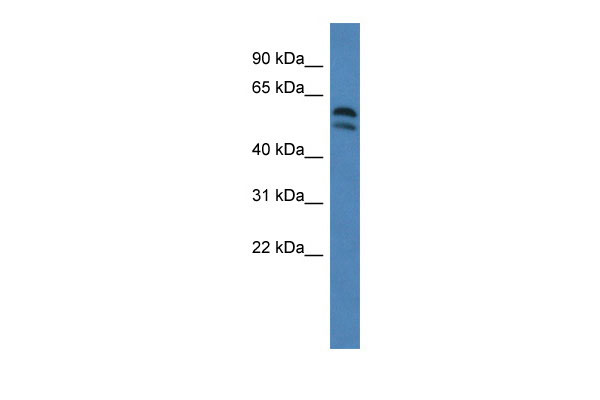Lpcat2 antibody - C-terminal region
Rabbit Polyclonal Antibody
- SPECIFICATION
- CITATIONS
- PROTOCOLS
- BACKGROUND

Application
| WB |
|---|---|
| Primary Accession | Q8BYI6 |
| Other Accession | NM_173014, NP_766602 |
| Reactivity | Human, Mouse, Rat, Rabbit, Zebrafish, Pig, Horse, Bovine, Guinea Pig, Dog |
| Predicted | Mouse, Rat, Rabbit, Pig, Chicken, Horse, Bovine, Guinea Pig, Dog |
| Host | Rabbit |
| Clonality | Polyclonal |
| Calculated MW | 60kDa |
| Gene ID | 270084 |
|---|---|
| Alias Symbol | A330042H22, Aytl1, LPCAT2, lpafat1, Aytl1a |
| Other Names | Lysophosphatidylcholine acyltransferase 2, LPC acyltransferase 2, LPCAT-2, LysoPC acyltransferase 2, 2.3.1.23, 1-acylglycerol-3-phosphate O-acyltransferase 11, 1-AGP acyltransferase 11, 1-AGPAT 11, 2.3.1.51, 1-acylglycerophosphocholine O-acyltransferase, 1-alkylglycerophosphocholine O-acetyltransferase, 2.3.1.67, Acetyl-CoA:lyso-platelet-activating factor acetyltransferase, Acetyl-CoA:lyso-PAF acetyltransferase, Lyso-PAF acetyltransferase, LysoPAFAT, Acyltransferase-like 1, Lpcat2, Aytl1, Aytl1a, Lpcat2a |
| Format | Liquid. Purified antibody supplied in 1x PBS buffer with 0.09% (w/v) sodium azide and 2% sucrose. |
| Reconstitution & Storage | Add 50 ul of distilled water. Final anti-Lpcat2 antibody concentration is 1 mg/ml in PBS buffer with 2% sucrose. For longer periods of storage, store at 20°C. Avoid repeat freeze-thaw cycles. |
| Precautions | Lpcat2 antibody - C-terminal region is for research use only and not for use in diagnostic or therapeutic procedures. |
| Name | Lpcat2 |
|---|---|
| Synonyms | Aytl1, Aytl1a, Lpcat2a |
| Function | Exhibits both acyltransferase and acetyltransferase activities (PubMed:17182612, PubMed:18156367, PubMed:18285344). Activity is calcium-dependent (PubMed:17182612). Catalyzes the conversion of lysophosphatidylcholine (1-acyl-sn-glycero-3- phosphocholine or LPC) into phosphatidylcholine (1,2-diacyl-sn-glycero- 3-phosphocholine or PC) (PubMed:17182612, PubMed:18156367). Catalyzes the conversion 1-acyl-sn-glycerol-3-phosphate (lysophosphatidic acid or LPA) into 1,2-diacyl-sn-glycerol-3-phosphate (phosphatidic acid or PA) by incorporating an acyl moiety at the sn-2 position of the glycerol backbone (By similarity). Involved in platelet-activating factor (PAF) biosynthesis by catalyzing the conversion of the PAF precursor, 1-O- alkyl-sn-glycero-3-phosphocholine (lyso-PAF) into 1-O-alkyl-2-acetyl- sn-glycero-3-phosphocholine (PAF) (PubMed:17182612, PubMed:18285344). Also converts lyso-PAF to 1-O-alkyl-2-acyl-sn-glycero-3-phosphocholine (PC), a major component of cell membranes and a PAF precursor (PubMed:17182612). Under resting conditions, acyltransferase activity is preferred (PubMed:17182612). Upon acute inflammatory stimulus, acetyltransferase activity is enhanced and PAF synthesis increases (PubMed:17182612). Involved in the regulation of lipid droplet number and size (By similarity). |
| Cellular Location | Endoplasmic reticulum membrane; Single-pass type II membrane protein {ECO:0000250|UniProtKB:Q7L5N7}. Golgi apparatus membrane; Single-pass type II membrane protein {ECO:0000250|UniProtKB:Q7L5N7}. Cell membrane; Single-pass type II membrane protein {ECO:0000250|UniProtKB:Q7L5N7}. Lipid droplet {ECO:0000250|UniProtKB:Q7L5N7} |
| Tissue Location | Highest expression is found in resident macrophages and casein-induced neutrophils followed by skin, colon, spleen and thioglycollate-induced macrophages. Detected in erythroleukemic cells but not in reticulocytes. |
If you have used an Abcepta product and would like to share how it has performed, please click on the "Submit Review" button and provide the requested information. Our staff will examine and post your review and contact you if needed.
If you have any additional inquiries please email technical services at tech@abcepta.com.














 Foundational characteristics of cancer include proliferation, angiogenesis, migration, evasion of apoptosis, and cellular immortality. Find key markers for these cellular processes and antibodies to detect them.
Foundational characteristics of cancer include proliferation, angiogenesis, migration, evasion of apoptosis, and cellular immortality. Find key markers for these cellular processes and antibodies to detect them. The SUMOplot™ Analysis Program predicts and scores sumoylation sites in your protein. SUMOylation is a post-translational modification involved in various cellular processes, such as nuclear-cytosolic transport, transcriptional regulation, apoptosis, protein stability, response to stress, and progression through the cell cycle.
The SUMOplot™ Analysis Program predicts and scores sumoylation sites in your protein. SUMOylation is a post-translational modification involved in various cellular processes, such as nuclear-cytosolic transport, transcriptional regulation, apoptosis, protein stability, response to stress, and progression through the cell cycle. The Autophagy Receptor Motif Plotter predicts and scores autophagy receptor binding sites in your protein. Identifying proteins connected to this pathway is critical to understanding the role of autophagy in physiological as well as pathological processes such as development, differentiation, neurodegenerative diseases, stress, infection, and cancer.
The Autophagy Receptor Motif Plotter predicts and scores autophagy receptor binding sites in your protein. Identifying proteins connected to this pathway is critical to understanding the role of autophagy in physiological as well as pathological processes such as development, differentiation, neurodegenerative diseases, stress, infection, and cancer.


